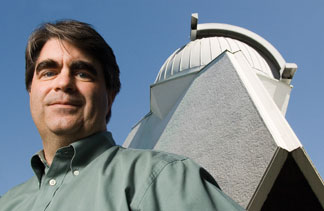|
Profiles: News about people from AGI and its 44 member societies
Archive of past Society Page/Profiles stories by date
Todd Hoeksema: A flare for all things solar
 Todd
Hoeksema has always been interested in space. As a child, he recalls,
he was fascinated by the nighttime sky and closely followed the pioneering
adventures of NASA’s Apollo and Gemini astronauts. But “by the
time I finished college, I had given up on being an astronomer,”
he says. “I didn’t think there was a job market.”
Todd
Hoeksema has always been interested in space. As a child, he recalls,
he was fascinated by the nighttime sky and closely followed the pioneering
adventures of NASA’s Apollo and Gemini astronauts. But “by the
time I finished college, I had given up on being an astronomer,”
he says. “I didn’t think there was a job market.”
Todd Hoeksema, a researcher at the Wilcox Solar Observatory at Stanford University in California, helped NASA create a new “roadmap” for future solar physics research. Photograph is by Linda Cicero.
In 1978, just before entering Stanford University’s graduate applied physics program, however, he decided to give space science one more try. At the urging of John Wilcox, a solar physicist at Stanford’s W.W. Hansen Experimental Physics Laboratory, he spent his summer at Stanford’s Solar Observatory (now the Wilcox Solar Observatory). That summer brought him back to space, he says, and changed his focus from the night sky to the daylight.
Now, after 30 years researching the sun at Stanford, Hoeksema has also helped design NASA’s new long-term plan for research in solar physics. From 2000 through 2004, Hoeksema advised NASA on the field’s key research questions and helped determine how new research on the sun’s impact on people and equipment can help NASA meet its goal of sending astronauts to Mars by 2030. In May, NASA recognized his leadership in designing solar physics’ new “roadmap” by awarding him a Distinguished Public Service Medal, its highest award for nongovernmental employees.
The combination of abstract beauty and practical application draws Hoeksema to the field, he says. “My interest is primarily the sun, but I’m also curious about how the sun affects Earth,” Hoeksema says. With technology increasingly affected by what happens in space, he adds, “the whole field has become more and more practical. It’s a neat evolution.”
Indeed, the field of solar physics has changed a great deal since Hoeksema joined the Stanford observatory’s team as a graduate student — one of only three scientists on the team at the time, says Phil Scherrer, director of the Wilcox Observatory. At the time, the research focus was largely on the sun itself, mapping its cycles and magnetic field, Hoeksema says, and only beginning to calculate its effects on Earth.
Hoeksema’s graduate project hinted at the work to come: His model of the sun’s corona eventually developed into a more sophisticated model of how changes in the direction of the sun’s magnetic field can produce major disturbances called geomagnetic storms. Those storms occur during periodic solar flares, which produce shockwaves of solar wind that also extend the sun’s magnetic field toward Earth.
Today, the group at Stanford is nearly 30 scientists strong, and the overall research focus has shifted to encompass the entire “heliosphere” — the region in which the sun affects not only Earth, but also the solar system and even beyond, Hoeksema says. “One of the things we’ve learned in the last several years is that you can’t study one part without studying the entire system,” he says.
That entire system has an enormous impact on people. Geomagnetic storms and other “space weather” can expose astronauts to dangerous radiation, and when the particles interact with Earth’s magnetic field, they can disrupt telecommunications on Earth by knocking out satellites. To protect both astronauts and the planet’s satellite network, NASA is now keenly interested in better predicting space weather (see Geotimes, October 2005), and Hoeksema has been key in these recent developments.
Part of the new research has involved better understanding what causes solar flares and other solar ejections. Hoeksema and other solar researchers at Stanford are helping to pioneer a new field, called “helioseismology” — sometimes referred to as solar dermatology because it studies phenomena on the sun’s surface such as sunspots, Hoeksema says.
They have designed instruments that aim to “listen” to the sound waves created by the sun’s boiling surface. They developed both the SONAR instrument, which flew on the joint NASA-European Space Agency SOHO mission in 1995, and are currently at work on a new instrument, called the Helioseismic and Magnetic Imager (HMI), which will be launched on NASA’s Solar Dynamics Observatory satellite in 2007. The next cycle of heightened sunspot activity is likely to be between 2010 and 2012.
In addition to his work as a scientist and NASA advisor, Hoeksema has helped drive the Stanford SOLAR Center, an outreach program to “help people understand what we’re doing,” Scherrer says. The outreach program aims to teach everyone from middle and high school students to the general public about the sun.
In his advisory capacity at NASA, Hoeksema says, he was an advocate for the community, but in the community, he found he was also a NASA advocate. He says that experience at NASA has been a different kind of whole-system approach, and has helped him see how decisions are made from the inside as well as from the outside.
“When you appreciate the inner workings you appreciate how things turn out,” he says — not unlike listening to the sun’s inner resonations, to predict its next cycle.
Carolyn Gramling
Links:
"New flare for space weather
prediction," Geotimes, October 2005

 Subscribe
Subscribe

